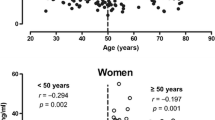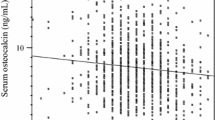Abstract
Objectives
Undercarboxylated osteocalcin (ucOC) has been proved as a regulator of glucose and fat mass in an animal model. This study examined the association between osteocalcin and metabolic syndrome (MetS) in postmenopausal women.
Methods
We selected 135 postmenopausal women and determined anthropometric values [waist-hip ratio (WHR), visceral fat area (VFA), body fat mass (BFM), and skeletal muscle mass (SMM)], the lipid profile, fasting plasma glucose (FPG), insulin, high-sensitivity C-reactive protein (hs-CRP), homeostasis model assessment of insulin resistance (HOMA-IR), serum leptin and adiponectin level, and serum tOC and ucOC level.
Results
There were 52 postmenopausal women in the MetS group. After adjusting for age and years since menopause, ucOC was negatively correlated with WHR, VFA, BFM, triglyceride, fasting insulin, HOMA-IR, and serum leptin and was positively correlated with serum adiponectin. The odds ratio for MetS was significantly lower in the highest quartile than the lowest quartile after adjusting for age, years since menopause, and BMI. In multiple regression analysis, serum leptin and HOMA-IR were the most important predictors of the independent variables that affect serum ucOC.
Conclusion
ucOC showed an inverse correlation with markers of insulin resistance, central obesity, and the presence of MetS in postmenopausal women and appears to protect against MetS. Further large-scale clinical and experimental studies are needed to clarify the potential of ucOC as a predictor of MetS in postmenopausal women.


Similar content being viewed by others
References
Isleten B, Durmaz B, Durmaz B, Onay H, Ozkinay F, Durmaz A, Turan V, Oztekin K (2013) The association of RANK gene C421T and C575T polymorphism with bone mineral density in postmenopausal Turkish women. Arch Gynecol Obstet 288(4):917–923
Eckel RH, Grundy SM, Zimmet PZ (2005) The metabolic syndrome. Lancet 365(9468):1415–1428
Davis SR, Castelo-Branco C, Chedraui P, Lumsden MA, Nappi RE, Shah D, Villaseca P (2012) Understanding weight gain at menopause. Climacteric 15(5):419–429
Ritland LM, Alekel DL, Matvienko OA, Hanson KB, Stewart JW, Hanson LN, Reddy MB, Van Loan MD, Genschel U (2008) Centrally located body fat is related to appetitive hormones in healthy postmenopausal women. Eur J Endocrinol 158(6):889–897
Wellen KE, Hotamisligil GS (2003) Obesity-induced inflammatory changes in adipose tissue. J Clin Invest 112(12):1785–1788
Cao JJ (2011) Effects of obesity on bone metabolism. J Orthop Surg Res 6:30
Kang AR, Oh YR, Kim HY, Park MJ, Joo BS, Choi WJ, Jung MH, Ji YI, Choi JS (2012) Up-regulation of inhibitors of DNA binding/differentiation gene during alendronate-induced osteoblast differentiation. Arch Gynecol Obstet 285(5):1331–1338
Hauschka PV, Lian JB, Cole DE, Gundberg CM (1989) Osteocalcin and matrix Gla protein: vitamin K-dependent proteins in bone. Physiol Rev 69(3):990–1047
Lee NK, Sowa H, Hinoi E, Ferron M, Ahn JD, Confavreux C, Dacquin R, Mee PJ, McKee MD, Jung DY, Zhang Z, Kim JK, Mauvais-Jarvis F, Ducy P, Karsenty G (2007) Endocrine regulation of energy metabolism by the skeleton. Cell 130(3):456–469
Hinoi E, Gao N, Jung DY, Yadav V, Yoshizawa T, Myers MG Jr, Chua SC Jr, Kim JK, Kaestner KH, Karsenty G (2008) The sympathetic tone mediates leptin’s inhibition of insulin secretion by modulating osteocalcin bioactivity. J Cell Biol 183(7):1235–1242
Clemens TL, Karsenty G (2011) The osteoblast: an insulin target cell controlling glucose homeostasis. J Bone Miner Res 26(4):677–680
Alberti KG, Zimmet PZ (1998) Definition, diagnosis and classification of diabetes mellitus and its complications. Part 1: diagnosis and classification of diabetes mellitus provisional report of a WHO consultation. Diabet Med 15(7):539–553
Wolf G (1996) Function of the bone protein osteocalcin: definitive evidence. Nutr Rev 54(10):332–333
Ducy P, Desbois C, Boyce B, Pinero G, Story B, Dunstan C, Smith E, Bonadio J, Goldstein S, Gundberg C, Bradley A, Karsenty G (1996) Increased bone formation in osteocalcin-deficient mice. Nature 382(6590):448–452
Neve A, Corrado A, Cantatore FP (2013) Osteocalcin: skeletal and extra-skeletal effects. J Cell Physiol 228(6):1149–1153
Ferron M, Wei J, Yoshizawa T, Del Fattore A, DePinho RA, Teti A, Ducy P, Karsenty G (2010) Insulin signaling in osteoblasts integrates bone remodeling and energy metabolism. Cell 142(2):296–308
Fulzele K, Riddle RC, DiGirolamo DJ, Cao X, Wan C, Chen D, Faugere MC, Aja S, Hussain MA, Bruning JC, Clemens TL (2010) Insulin receptor signaling in osteoblasts regulates postnatal bone acquisition and body composition. Cell 142(2):309–319
Ducy P (2011) The role of osteocalcin in the endocrine cross-talk between bone remodelling and energy metabolism. Diabetologia 54(6):1291–1297
Bae SJ, Choe JW, Chung YE, Kim BJ, Lee SH, Kim HY, Koh JM, Kim HK, Kim GS (2011) The association between serum osteocalcin levels and metabolic syndrome in Koreans. Osteoporos Int 22(11):2837–2846
Yang R, Ma X, Pan X, Wang F, Luo Y, Gu C, Bao Y, Jia W (2013) Serum osteocalcin levels in relation to metabolic syndrome in Chinese postmenopausal women. Menopause 20(5):548–553
Liu JJ, Toy WC, Wong MD, Tan CS, Tavintharan S, Wong MS, Sum CF, Lim SC (2013) Elevated undercarboxylated and reduced carboxylated osteocalcin are associated with metabolic syndrome in middle age Asian females. Exp Clin Endocrinol Diabetes 121(6):329–333
Saleem U, Mosley TH Jr, Kullo IJ (2010) Serum osteocalcin is associated with measures of insulin resistance, adipokine levels, and the presence of metabolic syndrome. Arterioscler Thromb Vasc Biol 30(7):1474–1478
Lu C, Ivaska KK, Alen M, Wang Q, Tormakangas T, Xu L, Wiklund P, Mikkola TM, Pekkala S, Tian H, Vaananen HK, Cheng S (2012) Serum osteocalcin is not associated with glucose but is inversely associated with leptin across generations of nondiabetic women. J Clin Endocrinol Metab 97(11):4106–4114
Chen L, Li Q, Yang Z, Ye Z, Huang Y, He M, Wen J, Wang X, Lu B, Hu J, Liu C, Ling C, Qu S, Hu R (2013) Osteocalcin, glucose metabolism, lipid profile and chronic low-grade inflammation in middle-aged and elderly Chinese. Diabet Med 30(3):309–317
Movahed A, Larijani B, Nabipour I, Kalantarhormozi M, Asadipooya K, Vahdat K, Akbarzadeh S, Farrokhnia M, Assadi M, Amirinejad R, Bargahi A, Sanjdideh Z (2012) Reduced serum osteocalcin concentrations are associated with type 2 diabetes mellitus and the metabolic syndrome components in postmenopausal women: the crosstalk between bone and energy metabolism. J Bone Miner Metab 30(6):683–691
Kanazawa I, Yamaguchi T, Yamauchi M, Yamamoto M, Kurioka S, Yano S, Sugimoto T (2011) Serum undercarboxylated osteocalcin was inversely associated with plasma glucose level and fat mass in type 2 diabetes mellitus. Osteoporos Int 22(1):187–194
Usui C, Asaka M, Kawano H, Aoyama T, Ishijima T, Sakamoto S, Higuchi M (2010) Visceral fat is a strong predictor of insulin resistance regardless of cardiorespiratory fitness in non-diabetic people. J Nutr Sci Vitaminol (Tokyo) 56(2):109–116
Hanley AJ, Karter AJ, Festa A, D’Agostino R Jr, Wagenknecht LE, Savage P, Tracy RP, Saad MF, Haffner S (2002) Factor analysis of metabolic syndrome using directly measured insulin sensitivity: the Insulin Resistance Atherosclerosis Study. Diabetes 51(8):2642–2647
Czernichow S, Kengne AP, Huxley RR, Batty GD, de Galan B, Grobbee D, Pillai A, Zoungas S, Marre M, Woodward M, Neal B, Chalmers J (2011) Comparison of waist-to-hip ratio and other obesity indices as predictors of cardiovascular disease risk in people with type-2 diabetes: a prospective cohort study from ADVANCE. Eur J Cardiovasc Prev Rehabil 18(2):312–319
Conflict of interest
The authors have stated explicitly that there are no conflicts of interest in connection with this article.
Author information
Authors and Affiliations
Corresponding author
Rights and permissions
About this article
Cite this article
Lee, S.W., Jo, H.H., Kim, M.R. et al. Association between osteocalcin and metabolic syndrome in postmenopausal women. Arch Gynecol Obstet 292, 673–681 (2015). https://doi.org/10.1007/s00404-015-3656-7
Received:
Accepted:
Published:
Issue Date:
DOI: https://doi.org/10.1007/s00404-015-3656-7




